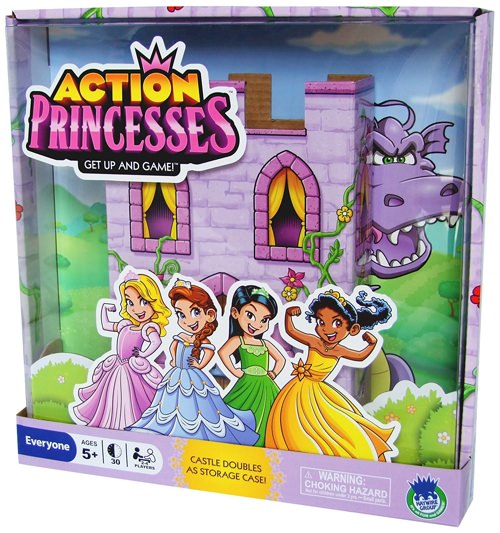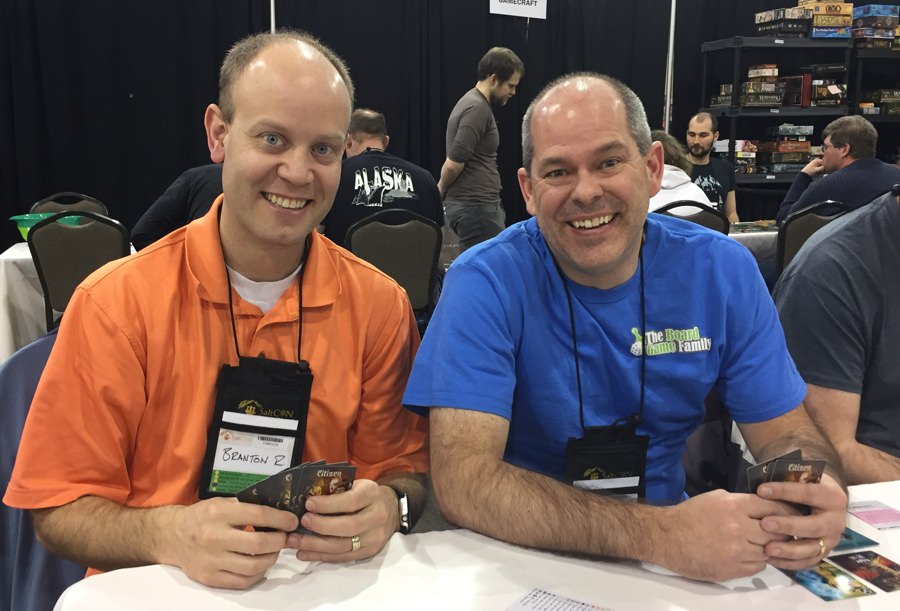Hive Mind rewards thinking alike
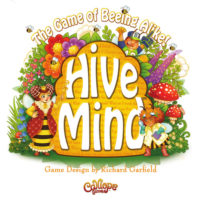
To be honest, when I first saw Hive Mind in the Calliope Games booth at Gen Con 2016 I didn’t think too much of it. From the outside, it looked like a children’s game that the everyone in our family would have outgrown.
However, after getting a copy from Calliope Games and giving it a shot, I’ve completely changed my tune!
Playing Hive Mind has been a lot of fun!
In fact, we enjoyed our first play so much that the following week I took it to our New Year’s Eve party with friends.
We were there with just adults playing and Hive Mind was a hit with everyone!
Like me, they were skeptical when I first pulled it out. But once we got playing, everyone had a blast.
How to play Hive Mind
Hive Mind is a very easy game to play.
We compare the objective in Hive Mind to be similar to stages of The Amazing Race or Survivor where you don’t want to be the one booted out of the race or tribe.
The goal in Hive Mind is to stay in the hive and not get kicked out.
Players who respond more like the majority will win.
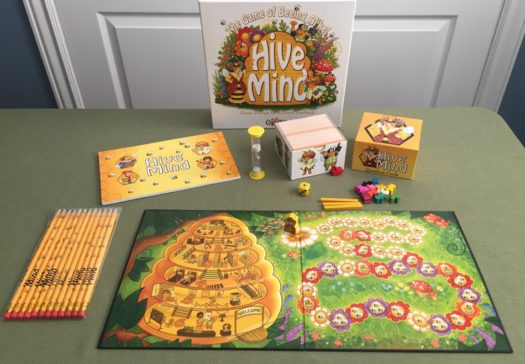
Set up
There are only a few things to do to set up Hive Mind.
All players choose a Bee meeple and place it at the top of the Hive. They also each get a pencil and paper (included in the game).
The 3 gate pieces are placed in their spaces at levels 4, 5, and 6.
The box of question cards is set to the side of the board along with the timer.
The Queen Bee is placed on the “Queen Bee Start” space and you’re ready to play.
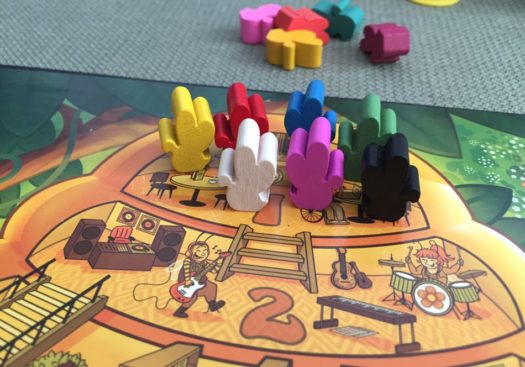
Playing
While there aren’t really any “turns” in Hive Mind, players do rotate picking the questions each round.
The active player rolls the die and moves the Queen Bee along the flower path that number of spaces. The new location of the Queen Bee determines how many bees will move in the hive after scoring this round.
For example, if the Queen is on a space showing just 1 bee, the players with the lowest score that round will move down one level in the hive (closer to the exit). If the Queen is on a space with 3 bees, the players with the lowest 3 scores will move down one level.
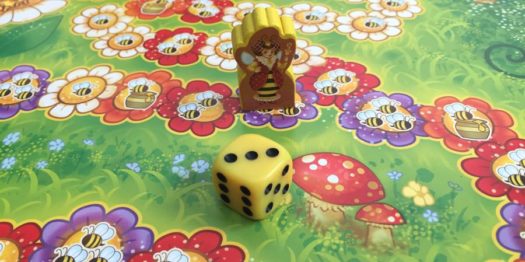
The active player then draws a question card and chooses one of the 3 questions on the card or makes up a question of their own. The cards are double-sided and the rules state to use just one side of the card each time you play through the box of questions. But we’ve chosen to let players pick questions from either side of the card.
After the active player reads the question, everyone writes down their answers on their pieces of paper. They have until the timer runs out. The included sand timer is a 2-minute timer but if you’d like to set your own timer length, feel free to do so.
Then the players read their answers and score points.
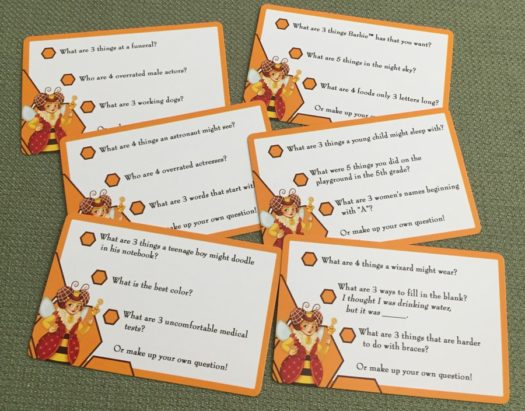
Scoring
Players automatically score 1 point for each of their own answers. So if the question says to name 5 things and a player only writes 4 things, they’ll get 4 points to begin. Plus players get 1 additional point for each other player that wrote down a matching response.
Once everyone has read their answers and scored points, players tally up their points for the round.
The players with the lowest scores move down in the hive according to where the Queen Bee is.
For example, if the scores are 13, 13, 12, 10, 9, 9, and 8 and the Queen Bee is on a spot with 2 bees, then the players with the lowest 2 scores (the 2 players who scored 9 and the 1 player who scored 8) will all move down one level.
If the Queen Bee is on a spot with 1 Bee & Honey Pot, then the players with the lowest score moves down one level while the players with the highest score move up one level. In the scoring example above, that would mean the player who scored 8 would move down and the 2 players who both scored 13 would move up.
If a bee needs to move down and there’s a gate in the way, the player’s bee stays put and the gate is removed. It’s a little bit of a reprieve for the bees in this situation while some other bees may now join them at that level.
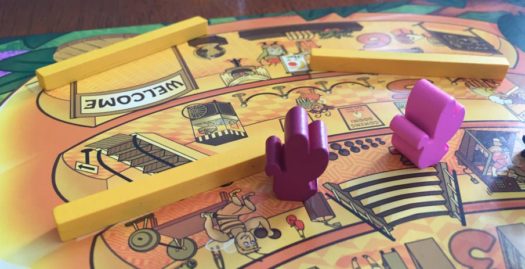
Game End
When one or more bees exit the hive from level 6, the game immediately ends.
All players still left in the hive win!
That’s right, there isn’t any final game scoring or anything. If you get booted from the hive, you lose and everyone else wins.
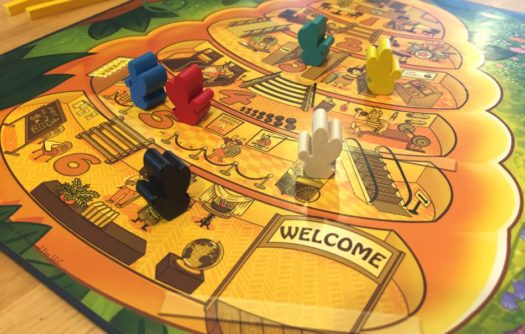
Can the whole family enjoy Hive Mind?
As we mentioned in the beginning, just looking at Hive Mind it’s easy to categorize it as a children’s game.
But it’s actually a fun game for the whole family.
Don’t be caught off guard by the cutesy artwork and bumblebee theme because the game play is great for players of all ages.
The only stipulation is that players should be old enough to write their answers. Of course, you could also work around that if you wanted to have a youngster team up with a parent as a scribe.
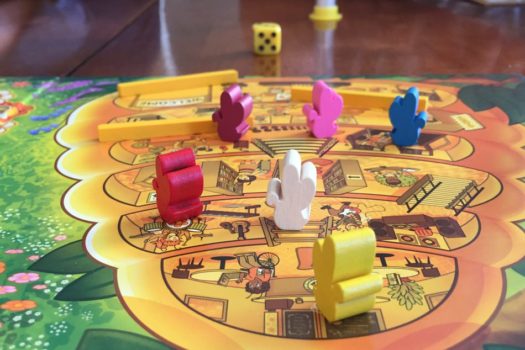
The fun tension in Hive Mind comes in doing well enough to get by. Rather than needing to get the most points each round, it’s more about staying away from being at the bottom. It’s the central scoring feature that makes the game very enjoyable.
The questions on the cards are also well suited for people of all ages. The topics of the questions may skew a bit to the younger side, but since there’s always an option for players to make up their own questions, this isn’t a problem at all for adults either.
Making up your own question can be very strategic as well. In our New Year’s Eve game, a couple players used that option to make sure they came out ahead by asking a question related to an obscure subject only they knew about. Since players can’t talk after the question is read, it didn’t give other players a chance to collude on how they’d answer to thwart the obvious plans of these then-losing players. But it sure made for a lot of laughs and future trash talking fun.
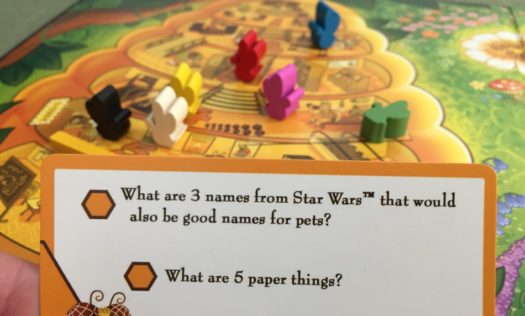
Many winners and 1 loser?
Because of how the game ends, it’s very possible to have only 1 loser and plenty of winners. Which may make you wonder about it being a good game for children. On one hand, the game may have multiple winners. And kids love to win. (Don’t we all?)
Yet on the other hand, a child may really not like it if they’re the only loser. That can be a very sinking feeling.
However, this also depends on how many players are in the game. There are 12 Bee meeples in the game so up to 12 players can play. And the more players you have, the less likely it is that there will be only 1 loser. It’s more likely that multiple players will get booted from the hive at the same time to end the game.
For teens and adults, the pressure to stay clear of being booted is awesome.
And if there’s only 1 loser among teens and adults, it’s actually quite fun.
How does Hive Mind score on our “Let’s Play Again” game meter?
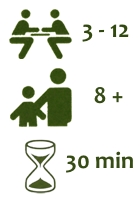 Hive Mind scores high on our “let’s play again” meter because of how simple and fun it is. The rules are simple and the game play is quick. And there isn’t any downtime because everyone participates in every question.
Hive Mind scores high on our “let’s play again” meter because of how simple and fun it is. The rules are simple and the game play is quick. And there isn’t any downtime because everyone participates in every question.
It’s also a game that can easily be played back-to-back. When one game ends, it’s super simple to just place the Bee meeples back at the top and keep answering more questions.
Plus, it can play up to 12 players!
So it’s a great game to pull out with just our family or with a bigger group of friends or extended family.
See how alike your family thinks and pick up a copy of Hive Mind.
We’d like to thank Calliope Games for a copy of Hive Mind to review.

